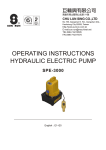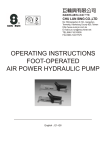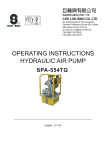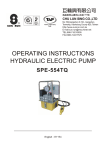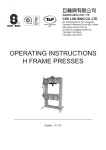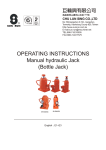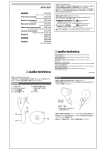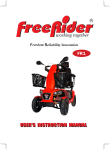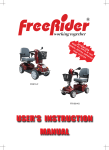Download OPERATING INSTRUCTIONS Portable High Tonnage Jack
Transcript
巨輪興有限公司 高雄市岡山區岡山北路199號 CHU LUN SING CO.,LTD R No.199,Gangshan N. Rd., Gangshan Township, Kaohsiung County 820, Taiwan http://www.sunrun.com.tw E-mail:[email protected] TEL:886-7-6210505 FAX:886-7-6217575 OPERATING INSTRUCTIONS Portable High Tonnage Jack SPLE- series English:E1~E12 Instructions for: Portable High Tonnage Jack Models:SPLE- series 1. SAFETY PRECAUTIONS Fail to comply with the following cautions and warnings could cause equipment damage and personal injury. IMPORTANT :Minimum age of the operator must be 18 years The operator must have read and understood all instructions, safety issues, cautions and warnings before starting to operate the SUN RUN equipment. The operator is responsible for this activity towards other persons. I ! WARNING : The system operating pressure must not exceed the pressure rating of the lowest rated component in the system. Install pressure gauges in the system to monitor operating pressure. It is your window to what is happening in the system. WARNING : To avoid personal injury and possible equipment damage, make sure all hydraulic components withstand the maximum pressure of 700 bar(10,000psi). CAUTION: Avoid sharp bends and kinks that will cause severe back-up pressure in hoses. Bends and kinks lead to premature hose failure. WARNING: Always wear safety glasses. The operator must take precaution against injury due to failure the tool or workpiece. DO NOT drop heavy objects on hose. A sharp impact may cause internal damage to hose wire strands. Applying pressure to a damaged hose may cause it to rupture. WARNING: Stay clear of loads supported by hydraulics. A cylinder, when used as a load lifting device, should never be used as a load holding device. After the load has been raised or lowered, it must always be blocked mechanically. WARNING: USE ONLY RIGID PIECES TO HOLD LOAD. Carefully select steel or wood blocks that are capable of supporting the load. Never use a hydraulic cylinder as a shim or spacer in any lifting or pressing application. DANGER: To avoid personal injury keep hands and feet away from cylinder and workpiece during operation. WARNING : Do not overload equipment. Overloading cause equipment failure and possible personal injury. The cylinders are designed for a max. Pressure of 700 bar (10,000psi). R ! DANGER: NEVER set the relief valve to a higher pressure than the maximum rated pressure of the pump. Higher settings may result in equipment damage and/ or personal injury. Do not remove relief valve. CHU LUN SING CO.,LTD IMPORTANT: Do not lift hydraulic equipment by the hoses or couplers. Use the carrying handle or other means of safe transport. CAUTION : KEEP HYDRAULIC EQUIPMENT AWAY FROM FLAMES AND HEAT. Excessive heat will soften packings and seals, resulting in fluid leaks. Heat also weakens hose materials and packings. For optimum performance do not expose equipment to temperatures of 650C(1500F) or higher. Protect hoses and cylinders from weld spatter. DANGER: Do not handle pressurized hoses. Escaping oil under pressure can penetrate the skin causing serious injury. If oil is injected under the skin, see a doctor immediately. Page:E1 Instructions for: Portable High Tonnage Jack Models:SPLE- series 2.SPECIFICATION 5段可調式把手 5 position adjustable handle. F D 含把手層疊墊塊及儲存筒 Cribbing blocks with handles and storage racks. E G 50~200噸強力荷載 Heavy-duty 50~200 ton lifting capacity. A 16" 輪胎 16" tires. 油缸螺牙連接底板 All steel cylinder is thread into base. B H 鋼製底板不像鑄鋼 容易斷裂 Steel base not prone to cracking like cast. 20呎遙控器 20 ft remote control. C 型 號Model No. SPLE-5013 SPLE-10013 特製 SPLE-15013 SPLE-20013 特製 Power Unit Cylinder Power Unit Cylinder Power Unit Cylinder Power Unit Cylinder 驅動單元 油缸型號 驅動單元 油缸型號 驅動單元 油缸型號 驅動單元 油缸型號 SPE-554TQJ RSR-5013 SPE-554TQJ RSR-10013 SPE-554TQJ RSR-15013 1-1/8HP 220V 10.7A 50/60Hz Single Phase 1-1/8HP 220V 10.7A 50/60Hz Single Phase Cap.: 498kN Stroke:334mm 80/95 1-1/8HP 220V 10.7A 50/60Hz Single Phase Cap.: 1386kN Stroke:333mm 外型尺寸 Dimensions (mm) DBa/ 700bar 噪音值 Cap.: 933kN Stroke:333mm A B 1538 850 C D 1592 659 E 660 SPE-554TQJ RSR-20013 1-1/8HP 220V 10.7A 50/60Hz Single Phase Cap.: 1995kN Stroke:330mm Tire Dia.(mm) F 458 G 52 輪胎直徑 436 XKSPLE5013-A01 XKSPLE5013-A02 XKSPLE10013-A01 XKSPLE10013-A02 38.5 44.5 139.7 76.5 82.5 139.7 38.5 44.5 187.3 76.5 82.5 187.3 XKSPLE15013-A01 XKSPLE15013-A02 38.5 44.5 222.2 76.5 82.5 222.2 XKSPLE20013-A01 XKSPLE20013-A02 38.5 44.5 254.2 76.5 82.5 254.2 50 173.0 515.9 16.3 A B 100 177.8 527.4 30.9 150 168.3 511.2 38.6 200 168.3 511.2 38.6 Total stack Ht. Dimensions (mm) Cribbing Blocks tons Jack Module Ext. Total stack Ht. Wt.(kg) 外型尺寸 適用噸數 整組總高 重量 突形墊塊 Model No. 層 墊塊型號 A B C C AB C G Wt. 外型尺寸 Dimensions (mm) tons Jack Module Ext. H 重量 適用噸數 Model No. B (kg) 型號 A A B C D E F G H XKSPLE5013-A03 223.8 173 127 66.8 1"-8UN 63.5 66.8 92.2 9.5 500 XKSPLE10013-A03 228.6 177.8 174.6 95.2 1-3/4"-12UN 76.2 98.4 95.0 18.2 100 XKSPLE15013-A03 219.2 168.4 203.2 114.3 3-3/8"-16UN 111.3 114.3 88.9 22.7 150 R CHU LUN SING CO.,LTD E F D C Page:E2 Instructions for: Portable High Tonnage Jack Models:SPLE- series 3.OPERATION Load Load cap Load from this direction only. 0 0 4 4 Max. Max. Pinch or crush point Extension and Cribbing blocks SUN RUN This guide cannot cover every situation, so always do the job with SAFETY FIRST. R CHU LUN SING CO.,LTD 1.Side load damage the jack or cause failure of the joint connecting the base or extensions resulting in loss of the load and possible personal injury. 2.Center load on jack. 3.Align load and jack so that stack force is straight and in line with the load and so that the movement of the load does not cause instability. 4.Do not drive or push the load off the jack. Lower jack and remove before moving the load. 5.Completely cover the top of the load cap with a secure and properly supported load lifting point. Do not lift-off-center on a rounded or uneven surface. 6.Lift by pushing against a flat surface parallel to the cylinder base within 4 degrees as shown. 7.Always place the tallest extension on the bottom and the shortest on the top when stacking extensions. 8.Always pin the first extension (the tallest one used) to the piston rod to prevent accidental disengagement of the connection. 9.Use only one of the shortest extensions (black in color and also referred to as load caps) at a time. Never stack them! 10.Cribbing blocks must be fully seated and evenly loaded. 11.Do not use more cribbing blocks than those provided with one complete set. Use only one set. Do not add components. 12.Do not lower the load directly onto the cribbing blocks. 13.Use each set only with the cylinder for which it was designed. 14.Read and understand all operating instructions and warnings. 15.If cribbing is used it must be installed properly. Align handles, seat fully into recessed diameters before lowering piston extension adaptor onto cribbing. 16.Follow lifted load with cribbing or blocks. 17.Use only approved accessories. 18.Use a jack with sufficient capacity to lift the load. 19.The total load, lifted or supported by a jack, must never exceed the rated capacity of the jack. 20.Never support a load hydraulically. 21.All loads must be supported mechanically. 22.Properly support the jack and jack bases. 23.Use a friction material under base and between jack and load. 24.Lift only dead weight loads. 25.Stay clear of lifted loads. 26.Do not work on or near unsecured loads. Do not allow personnel or dynamic forces on an unsecured load. 27.Do not use jack(s) if damaged, altered or in poor repair. Page:E3 Instructions for: Portable High Tonnage Jack Models:SPLE- series 3.OPERATION 3.1 Instructions required to put portable jack into service 3.1.1 Carefully read and understand the safety precautions and operating instructions which describe general safety precautions and the method required to connect the pump, hoses, fittings, and jack. Since this unit has been completely assembled and tested at our factory, follow the succeeding steps to put the jack into service. 3.1.2 Carefully remove all packing materials from the assembled unit. 3.1.3 Fill pump reservoir to proper operating level using approved SUN RUN hydraulic oil. 3.1.4 Start pump and cycle jack to full extension, then to full retraction, three or more times until the jack advance and retracts smoothly throughout the cycle. 3.1.5 Allow the pump to build to full pressure with the jack first fully extended, and then fully retracted. Stop pump and check each hose, fitting, and other system components for any oil leakage. If any leakage is found, correct the problem and retest. 3.2 Bleeding air from the system The portable jack has been bled at the factory, however, air can accumulate in the hydraulic system if the reservoir oil level is too low or if the unit has not been used for a prolonged period. This air cause the jack to respond in an unstable or slow manner. Before attempting to lift a load for the first time remove the air: 1. With no load on the jack, cycle the hydraulic system three or more times (fully extend and retract the jack). 2.Check the pump reservoir level. Refer to the pump operating instructions for the proper fill level and direction on how to add oil if necessary. 3.3 Only qualified individuals should operate this equipment. Position the unit under the load to be lifted and select the extension or extensions required. 0 3.4 The cylinder must not exceed ±4 from centerline alignment at any time, with or without extensions. To lower to load: Start the unit and raise the load just enough to remove the cribbing blocks. Switch the valve to retract and lower the load. NOTE: This uit is equipped with a load lowering valve that requires pump pressure throughout the lowering operation. NOTE: Unit weight=237kg without extensions or cribbing blocks. Transport with care. R CHU LUN SING CO.,LTD Page:E4 Instructions for: Portable High Tonnage Jack Models:SPLE- series 3.OPERATION 3.5 Double-acting Hydraulic System A basic double-acting hydraulic system consists of a pump (which moves the hydraulic fluid), a double-acting cylinder or ram (to do the work), a hydraulic hose (which routes the fluid to the advance cylinder or ram port), a second hydraulic hose (which routes the fluid to the retract cylinder or ram port), and a control valve which can change the direction of the hydraulic fluid. TYPICAL INSTALLATION SUN RUN A double-acting cylinder or ram can be either extended or retracted hydraulically. Most double-acting cylinders or rams are classed as "differential cylinders" because of the different sized areas that the hydraulic fluid pushes against during the extend and retract strokes. Because of this difference, the extend stroke can exert more force than the retract stroke. NOTE: The capacity of a hydraulic system is determined by the effective area of the cylinder and the system pressure. 3.6 SAFETY PRECAUTIONS 3.6.1 A double-acting cylinder or ram must have both hoses and all couplers securely connected to both ports. If one of the two ports is restricted or becomes disconnected, pressure will build and the cylinder, hose or coupler can burst, possibly causing serious injury or death. 3.6.2 When extending double-acting cylinders or rams, the retract port must not be restricted. A restricted retract port will prevent pressure from being released and the cylinder can burst, possibly causing serious injury or death. 3.6.3 Do not attempt to adjust or service the rod end relief valve on a double-acting cylinder or ram. If oil leakage is detected from this relief valve, discontinue use of the cylinder or ram immediately and contact your nearest Authorized Hydraulic Service Center. If improperly adjusted, the cylinder or ram could develop excessive pressure and cause the cylinder, hose or couplers to burst which could cause serious injury or death. Typical relief valve location R CHU LUN SING CO.,LTD Page:E5 Instructions for: Portable High Tonnage Jack Models:SPLE- series 3.OPERATION 3.6 SAFETY PRECAUTIONS 3.6.4 When extending a cylinder or ram under load, always insure that the couplers or port threads have not been damaged or do not come in contact with any rigid obstruction. If this condition does occur, the coupler's attaching threads may become stripped or pulled from the cylinder or ram resulting in the instantaneous release of high pressure hydraulic fluid, flying objects, and loss of the load. All of these possible results could cause serious injury or death. 3.6.5 Avoid off-center loads which could damage the cylinder or ram and/or cause loss of the load, possibly causing serious injury or death. 3.6.6 Control the load at all times. Do nit drop the load. 3.6.7 Properly rated adapters be installed and used correctly for each application. 3.6.8 WARNING 3.6.8.1 Hydraulic Hose and Fluid Transmission Lines A) Avoid straight line tubing connections in short runs. Straight line runs do not provide for expansion and contraction due to pressure and/or temperature changes. B) Eliminate stress in the tube lines. Long tubing runs should be supported by brackets or clips. Tubes hrough bulkheads must have bulkhead fittings. This makes easy removal possible and helps support the tubing. C) Before operating the pump, all hose connections must be tightened with the proper tools. Do not overtighten. Connections should only be tightened securely and leak-off. Overtightening can cause premature thread failure or high pressure fittings to split at pressure lower than their rated capacities. D) Should a hydraulic hose ever rupture, burst, or need to be disconnected, immediately shut off the pump and release all pressure. Never attempt to grasp a leaking pressurized hose with your hands. The force of escaping hydraulic fluid could cause serious injury. E) Do not subject the hose to potential hazard such as fire, sharp surfaces, extreme heat or cold, or heavy impact. Do not allow the hose to kink, twist, curl, cut, or bend so tightly that the fluid flow within the hose is blocked or reduced. Periodically inspect the hose for wear, because any of these conditions can damage the hose and possibly result in personal injury. F) Do not use the hose to move attached equipment. Stress can damage the hose and possibly cause personal injury. G) Hose material and coupler seals must be compatible with the hydraulic fluid used. Hoses also must not come in contact with corrosive materials such as creosote-impregnated objects and some paints. Hose deterioration due to corrosive materials can result in personal injury. Consult the manufacture before painting a hose. Never paint a coupler. R CHU LUN SING CO.,LTD Page:E6 Instructions for: Portable High Tonnage Jack Models:SPLE- series 3.OPERATION 3.6 SAFETY PRECAUTIONS 3.6.8 WARNING 3.6.8.2 Cylinder A) The user must be a qualified operator familiar with the correct operation, maintenance, and use of the cylinders. Lack of knowledge in any of these areas can lead to personal injury. B) Read and understand all safety and warning decals and instructions. C) Use only approved accessories and approved hydraulic fluid. Hoses, seals and all components used in a system must be compatible with the hydraulic fluid used. D) Do not exceed the rated capacities of the cylinders. Excess pressure can result in personal injury. E) Inspect each cylinder, fitting, tube line, hose, valve and coupler before each shift or usage to prevent unsafe conditions from developing. F) Do not use cylinder with bent or damaged couplers or damaged port threads. G) Under certain conditions, the use of an extension with a hydraulic cylinder may not be advisable and could present a dangerous condition. H) Avoid pinch points or crush points that can be created by the load or parts of the cylinder. I) To help prevent material fatigue if the cylinder is not be used in a continuous application, the load should not exceed 85% of the rated capacity. J) Cylinder must be on a stable base which is able to support the load while pushing or lifting. K) To help prevent personal injury, use shims, friction material or constraints to prevent slippage of the base or load. L) Surfaces contacting the cap must be parallel to the base supporting surface within 40. M) At least 75% of the load cap and base must be supported securely when pushing or lifting a load. N) Block or secure the load to prevent movement during lifting. O) Do not set poorly-balanced or off-center loads on a cylinder. The load can tip or the cylinder can "kick out" and cause personal injury. 0 P) Do not exceed 4 misalignment of the load on the cap. Q) If this component is used to lift or lower loads, be certain that the load is under operator control at all times and that others are clear of the load. Do not drop the load. R) As the load is lifted, use blocking and cribbing to guard against a falling load. S) To help prevent personal injury, do not allow personnel to go under or work on a load before it is properly cribbed or blocked. All personnel must be clear of the load before lowering. T) Never use extreme heat to disassemble a hydraulic cylinder or ram, Metal fatigue and/or seal damage will result and can lead to unsafe operating conditions. U) Do not created an uneven fulcrum and lever condition or overload condition where force exerted by one cylinder on a lever will intensify downward force on a pressure-checked cylinder at the other end of the lever. For example: If straightening an axle as illustrated, when Cyl.A Cyl.B cylinder A extends, and uneven fulcrum and lever condition will intensify force downward on pressure-checked cylinder B. The pressure created in cylinder B will be increased to dangerously high levels. R CHU LUN SING CO.,LTD Page:E7 Instructions for: Portable High Tonnage Jack Models:SPLE- series 3.OPERATION 3.6 SAFETY PRECAUTIONS 3.6.9 IMPORTANT A) Keep the cylinder clean at all time. B) While at a job site, when the cylinder is not in use, keep the piston rod fully retracted. C) Use an approved, high-grade pipe thread sealant to sealant to seal all hydraulic connections. Teflon tape can be used if only one layer of tape is used and it is applied carefully (two threads back) to prevent the tape from being pinched by the coupler and broken off inside the pipe end. Any loose pieces of tape could travel through the system and obstruct the flow of fluid or cause jamming of precision-fit parts. D) Always use protective covers on disconnected quick couplers. E) When mounting cylinders or rams using the internal piston rod threads, collar threads, threaded tie rods or base mounting holes, the threads must be fully engaged. 3.7 SYSTEM EVALUATION Cylinder, hose(s), couplings and pump all must be rated for the same maximum operating pressure, correctly connected and compatible with the hydraulic fluid used. An improperly matched system can cause the system to fail and possibly cause serious injury. If you are in doubt, consult your nearest SUN RUN facility. 3.7.1 BLEEDING THE SYSTEM The SUN RUN portable jack has been cycled at the factory, but to insure proper operation, each unit should be cycled (full extension and retraction) two or more times. 3.7.2 INSPECTION Before each use, visually inspect for the following items: A) Cracked or damaged cylinder. B) Excessive wear, bending, damage, or insufficient thread engagement. C) Leaking hydraulic fluid D) Scored or damaged piston rod E) Improperly functioning or damaged heads and caps F) Loose bolts or cap screws G) Damaged or improperly assembled accessory equipment H) Modified, welded, or altered equipment I) Bent or damaged couplers or port threads R CHU LUN SING CO.,LTD Page:E8 Instructions for: Portable High Tonnage Jack Models:SPLE- series 4. Maintain oil level 4.1 RAM AND CYLINDER MAINTENANCE A) Always use clean, approved hydraulic fluid and change as needed. B) Any exposed threads (male or female) must be cleaned and lubricated regularly, and protected from damage. C) If a cylinder or ram has been exposed to rain, snow, sand, grit-laded air, or any corrosive environment it must be cleaned, lubricated, and protected immediately after exposure. 4.2 PERIODIC CLEANING A routine should be established to keep the hydraulic system as free from dirt as possible. All unused couplers must be sealed with dust covers. All hose connections must be free of dirt and grime. Any equipment attached to the cylinder must be kept clean. WARNING: Contamination of the hydraulic fluid could cause the valve to malfunction. Loss of the load or personal injury could result. Use only SUN RUN hydraulic fluid and change as recommended or sooner if the fluid becomes contaminated (never exceed 300 hours). 4.3 STORAGE Double-acting cylinder These units should be stored in a dry, well-protected area where they will not be exposed to corrosive vapors, dust or other harmful elements, If a unit has been stored for a year or more, it must be thoroughly inspected before it is used. R CHU LUN SING CO.,LTD Page:E9 Instructions for: Portable High Tonnage Jack Models:SPLE- series 5.TROUBLESHOOTING Problem Erratic action Cylinder does not move. Cause Solution 1.Air in system or pump cavitation 1.Add fluid, bleed air and check for leaks. 2.Internal leakage in cylinder 2.Replace worn packings. Check for excessive contamination or wear. Replace contaminated fluid as necessary. 3.Cylinder or valve sticking or binding 3.Check for dirt or leaks. Check for bent, misaligned, worn parts or defective packings. Replace contaminated hydraulic oil with clean, compatible hydraulic oil. 4.Malfunctioning valve 4.Replace. This valve is NOT serviceable. 1.Loose couplers. 1.Tighten couplers. 2.Faulty coupler. 2.Verify coupler is not locked up. Replace as needed. 3.Improper valve position. 3.Close release valve or shift to new position. 4.Fill and bleed the system. 4.Low or no hydraulic fluid in pump reservoir. 5.Air-locked pump. 5.Prime pump per pump operating instructions. 6.Pump not operating. 6.Check pump's operating instructions. 7.Load is above the capacity of the system. 7.Use the correct equipment. 8.Fluid leaks out of rod end relief 8.Make sure all couplers are fully valve. coupled. Contact SUN RUN office nearest to you for advice technical assistance. R 9.No pilot pressure. 9.Check connections, pump valve position, and pressure. 10.Malfunctioning valve. 10.Replace. This valve is NOT serviceable. CHU LUN SING CO.,LTD Page:E10 Instructions for: Portable High Tonnage Jack Models:SPLE- series 5.TROUBLESHOOTING Problem Cylinder extends only partially Cylinder moves slower than normal. Cause 1.Pump reservoir is low on hydraulic fluid. 1.Fill and bleed the system. 2.Load is above the capacity of the system. 2.Use the correct equipment. 3.Cylinder piston rod binding. 3.Check for dirt or leaks. Check for bent, misaligned, worn parts or defective packings. 1.Loose connection or coupler. 1.Tighten. 2.Restricted hydraulic line or fitting. 2.Clean and replace if damaged. 3.Pump not working correctly. 3.Check pump operating instructions. 4.Replace worn seals. Check for excessive contamination or wear. 4.Cylinder seals leaking. Cylinder moves but does not maintain pressure. Solution 1.Leaky connection. 1.Clean, reseal with thread sealant and tighten connection. 2.Cylinder seals leaking. 2.Replace worn seals. Check for excessive contamination or wear. Replace contaminated fluid as necessary. 3.Pump or valve malfunctioning. 3.Check pump or valve operating instructions. Cylinder leaks hydraulic fluid. 1.Worn or damaged seals. 2.Loose connections. 3.Rod end relief valve has activated. R CHU LUN SING CO.,LTD 1.Replace worn seals. Check for excessive contamination or wear. Replace contaminated fluid as necessary. 2.Clean, reseal with thread sealant and tighten connection. 3.Make sure all couplers are fully coupled. If relief valve is still leaking, do not attempt to service this component. Contact SUN RUN office nearest to you for advice technical assistance. Page:E11 Instructions for: Portable High Tonnage Jack Models:SPLE- series 5.TROUBLESHOOTING Problem Cause Cylinder will not retract or retracts 1.Pump release valve closed. slower than normal Solution 1.Open pump release valve. 2.Loose couplers. 2.Tighten couplers. 3.Blocked hydraulic lines. 3.Clean and flush. 4.Cylinder damaged internally. 4.Send to service center for repair. 5.Pump reservoir too full. 5.Drain hydraulic fluid to correct level. 6.Pump or valve malfunctioning. 6.Check pump or valve operating instructions. R CHU LUN SING CO.,LTD Page:E12













